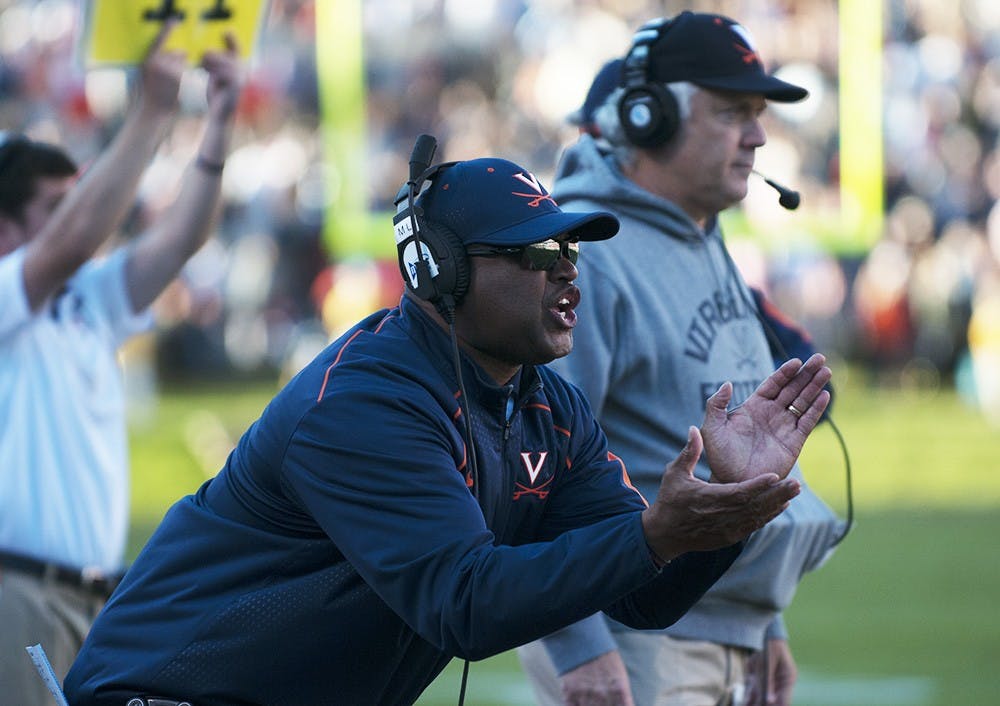A day after the triple overtime victory against Syracuse, I overheard a woman express her discontent with fans “booing the players going into halftime.” The comment caught me a little off guard. I myself had been booing at Scott Stadium as the clock wound down at the end of the second quarter, but it wasn’t directed at the players. I assumed most of the other boos from the crowd weren’t either.
I was verbally expressing my frustration with coach Mike London’s decision to knee the ball on the 25 yard line with 24 seconds on the clock and two timeouts in his pocket. The Cavaliers were down a touchdown to the Orange but literally wasted a possession. Two timeouts with 24 seconds would give Virginia at least three plays to move downfield in an attempt to score before halftime. They would only need to go about 45 yards to get into field goal range, and that was clearly possible in the scenario.
The odds of getting 45 yards in just three plays aren’t high, but Mike London opted to not even try. Theoretically, teams go over two-minute drills in practice — attempting to drive the length of the field in under two minutes for a touchdown — precisely for these types of situations. By not pulling out the two-minute offense, London was decreasing his team’s chances of winning — an abominable action from a head coach.
The worst part about the knee going into halftime was that it wasn’t unexpected. While not completely averse to a hurry-up offense in certain circumstances, London has a long history of leaving these possessions on the field. Just a week before against Pitt, he opted to take a knee on the 13 yard line with 26 seconds and two timeouts, going into halftime down a touchdown.
Even worse, against Notre Dame earlier this year Virginia got the ball with 1:24 left in the half and one timeout, posted up on their own 32 yard line and ahead by only two points. On first down, quarterback Matt Johns threw a pass into the backfield for a loss, and on second down, running back Taquan Mizzell rushed for no gain. The Cavaliers let those 84 seconds float away without throwing a pass downfield, calling the timeout, or even attempting a third down play.
There have been even more egregious instances in years past, but you get the idea.
Contrast that to great football coaches like the New England Patriot’s Bill Belichick. During the team’s two minute drill closing out the second half against the Colts on Sunday, color commentator Chris Collinsworth noted Belichick’s affinity for doing everything possible to score going into halftime, given how demoralizing it can be for the other team. Collinsworth noted how the coach revelled in the rare opportunities where the Patriots had an opportunity to score on two possessions in a row, once immediately before and once immediately after halftime.
There are two arguments I’ve heard against trying to score points going into halftime, and neither are very convincing.
The first is that it’s an acceptable strategy when you get the ball to start the third quarter. The thinking is that since we get the ball next anyway, there’s no harm ending this drive short. But the fact that you get the ball next has nothing to do with the possession at hand. Whether you score or don’t score, you still get the ball to start the second half. Why not try to score twice in back-to-back possessions, à la Bill Belichick. Virginia hasn’t exactly been in a position of scoring too many points this season.
The second argument is that there’s no need to risk a turnover when the chances of scoring aren’t very high. This is also expressed as the “just get the boys into halftime” strategy expressed when the team hasn’t performed exceptionally or is holding a small lead it might not deserve. The thinking: why risk giving up a lead or making things worse with a turnover when you can lock in your position with a knee or a rush for no gain?
This thinking is poor because it shows a complete lack of faith in both your offense and your defense. You have to trust your offense to go three to six plays without a turnover, or at least trust your defense to stop the other team from scoring in whatever seconds may remain after a turnover. And if you’re throwing the ball downfield and toward the sidelines — as you typically should in a two-minute offense — an interception won’t hurt much more than a punt.
In one of the instances when Virginia did opt to run a hurry up offense to close the half, that’s exactly what happened. Against William & Mary, Virginia attempted to march downfield after getting the ball on its 31 with 1:17 on the clock. The drive ultimately ended with an interception, but it came on the William & Mary 11 yard line, giving the Tribe no opportunity to do anything with the ball.
I don’t expect these short possessions at the end of the half to turn into points on even a remotely frequent basis. But I do expect the team to try, and leaving clock and timeouts on the field is the definition of not trying. That is why I boo — not at the players, but at our coach’s apparent lack of effort and drive.
Matt Comey is a weekly Sports Columnist for The Cavalier Daily. He can be reached at m.comey@cavalierdaily.com. Follow him on Twitter @matthewcomey.







